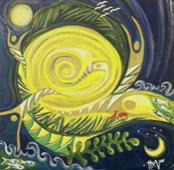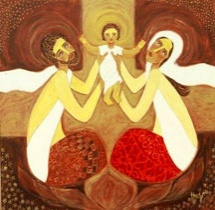 |
Editor’s note: Hanna Varghese is a Malaysian artist who uses acrylics and batik-dyeing to share biblical themes with her audience. After being inspired by the artwork of various Asian Christian artists, Varghese began her own journey to use painting and drawing to share her faith. Her pieces have been exhibited in various galleries throughout Asia. Varghese was recently interviewed by LWP editorial coordinator Laurie Fortunak.
LWP: Describe your faith journey. How and when did you come to trust in Christ?
HV: My faith journey has been a constant one. Certainly there were questions, doubts, study and conviction, and in all these there was the quiet spiritual experience. There was no dramatic defining moment like the Apostle Paul had. I come from a traditional Christian background and was influenced by Bible teachings, faith with prayer and worship.
LWP: What is it like to be a Christian in Malaysia? Are there any unique challenges you face as a Christian there?
HV: The Constitution of Malaysia says that we have freedom of religion, so there are churches of all denominations. Christians are represented and speak as one voice through the Council of Churches of Malaysia (CCM) and the Christian Federation of Malaysia (CFM). However, there are difficulties if a Muslim wishes to convert to any other religion. Yet we have inter-religious dialogue for better understanding to live peacefully as friends and as neighbours.
Also, burial grounds are getting limited for the Christian dead and our leaders have to negotiate for such land. Many Christian groups have become innovative when they cannot get land for building churches; they resort to converting shop lots and warehouses into worship centres. It reminds me of the very early churches!
LWP: How did you come to use art as your way of witnessing?
HV: As a child I loved drawing. We had a Bible storybook at home with vivid illustrations which left a lasting impression on me. Although I could not read at that time, the pictures made sense to me. Image is the tangible form of our thoughts and our spoken and written words. I could read into the pictures and interpret what they were saying. The images I make today are windows for others to look into my interpretation. That is witnessing.
 Creation
|
LWP: When interviewed once, you said, “This is my way of witnessing for Christ with the gift I have been blessed with.” How do you use your art to do that?
HV: Some can preach, some teach, some sing, some compose; others write and paint. The imageries that I perceive as I read, meditate and experience, I put into tangible forms for others to see. My hope is that more people will use images as another dimension in scripture education, meditation and inculturation, especially in seminaries, where the deep meaning of theology is taught and understood.
![]()

The Lost Coin
|
LWP: Describe your art.
HV: My art expressions for the past several years have centered on my innermost spiritual meditative thoughts. I use more of certain colours like yellow, blue and green to express light and calmness. I like movement and rhythmic patterns in my work. I observe and am aware of peoples’ expressions and reactions.
LWP: How is art effective in sharing the gospel both in Malaysia and around the world?
HV: One Chinese proverb says, “A picture speaks a thousand words.” A picture is visual; it draws your attention. With most visuals, we can see, understand the meaning and even “read” into them. Art is universal. It is amazing to see the gospel message in many local forms confirming that the message of salvation is for all people
LWP: What advice would you give to Christians and the global Church about using art for evangelism?
HV: All creative expression, be it the spoken word, the written word or the sung word are essentials in evangelism. Let us not forget the rightful place of visual images too. Art is the “seeing” word, the tangible word. Remember God “created” and “it was good.” Only when we perceive the beautiful can we say, “The heavens are telling the glory of God and the firmament proclaims his handiwork” (Psalm 19:1). Christian communities should look into the possibilities [of including] art in their praise and worship, education and veneration (as in icon).
Art is the expressive cry of the soul. All of us have that urge in one form or another. Discover it; nurture it.

